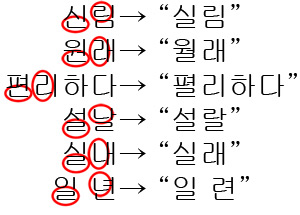Difference between revisions of "ㄴ + ㄹ"
From Korean Wiki Project
DigitalSoju (Talk | contribs) (New page: '''Pronunciation 'Rule:''' *Case 1: 'ㄴ' 받침 + 'ㄹ' → ㄴ gets pronounced as ㄹ *Case 2: 'ㄹ' 받침 + 'ㄴ' → ㄴ gets pronounced as ㄹ If the 받침 is a ㄴ...) |
DigitalSoju (Talk | contribs) (→Examples) |
||
| (14 intermediate revisions by one user not shown) | |||
| Line 1: | Line 1: | ||
'''Pronunciation 'Rule:''' | '''Pronunciation 'Rule:''' | ||
| − | * | + | *'ㄴ' [[받침]] + 'ㄹ' → ㄴ gets pronounced as ㄹ |
| − | + | <br> | |
| − | + | ||
| − | + | ||
If the [[받침]] is a ㄴ and it is followed byㄹ or if the [[받침]] is a ㄹ and followed by a ㄴ, the ㄴ sound becomes a ㄹ sound. This rule also applies even if ㄹ or ㄴ appear in another word, for example "일 년"(one year) gets pronounced as "일련." | If the [[받침]] is a ㄴ and it is followed byㄹ or if the [[받침]] is a ㄹ and followed by a ㄴ, the ㄴ sound becomes a ㄹ sound. This rule also applies even if ㄹ or ㄴ appear in another word, for example "일 년"(one year) gets pronounced as "일련." | ||
| + | <br> | ||
| + | <br> | ||
| + | Similarly, 'ㄴ' [[받침]] + 'ㄹ' → ㄴ gets pronounced as ㄹ. See [[ㄹ + ㄴ]] for more examples. | ||
[[Image:Nr_consnt_assim.jpg|center|Some examples]] | [[Image:Nr_consnt_assim.jpg|center|Some examples]] | ||
| − | == | + | |
| + | ==Examples== | ||
*곤란 → "골란" | *곤란 → "골란" | ||
*연락 → "열락" | *연락 → "열락" | ||
| − | * | + | *신랑 → "실랑" |
| + | *문래 → "물래" | ||
| + | *신랑 → "실랑" | ||
| + | *신라 → "실라" | ||
| + | *인류 → "일류" | ||
| + | *훈련 → "훌련" | ||
| + | *전락도 → "절라도" | ||
| + | *한라산 → "할라산" | ||
| + | *원람 → "월람" | ||
==Exceptions== | ==Exceptions== | ||
| − | The subway station "선릉역" frequently gets pronounced as "Seonleung," so the ㄴ gets pronounced as normal and the ㄹ pronounced as | + | * 신라면 doesn't follow this rule, it's pronounced as "신" "라면", where ㄴ stays as an /n/ sound. |
| − | + | * Konglish words such as 원룸(one room) also get pronounced similarly to it's original pronunciation. | |
| − | + | * The subway station "선릉역" (named after the Joseon Dynasty royal tomb nearby "선릉") frequently gets pronounced as "Seonleung," so the ㄴ gets pronounced as normal and the ㄹ pronounced as /l/. | |
| + | * Foreign names written in Hangeul also tend to ignore this rule, for example the name Henry would get transliterated as 헨리 and pronounced similarly to that of it's original English pronunciation rather than 헬리. | ||
| + | ==See also== | ||
| + | * [[ㄹ + ㄴ]] | ||
| − | [[Category:Consonant | + | [[Category:Consonant assimilation]] |
Latest revision as of 23:49, 21 July 2023
Pronunciation 'Rule:
- 'ㄴ' 받침 + 'ㄹ' → ㄴ gets pronounced as ㄹ
If the 받침 is a ㄴ and it is followed byㄹ or if the 받침 is a ㄹ and followed by a ㄴ, the ㄴ sound becomes a ㄹ sound. This rule also applies even if ㄹ or ㄴ appear in another word, for example "일 년"(one year) gets pronounced as "일련."
Similarly, 'ㄴ' 받침 + 'ㄹ' → ㄴ gets pronounced as ㄹ. See ㄹ + ㄴ for more examples.
Examples
- 곤란 → "골란"
- 연락 → "열락"
- 신랑 → "실랑"
- 문래 → "물래"
- 신랑 → "실랑"
- 신라 → "실라"
- 인류 → "일류"
- 훈련 → "훌련"
- 전락도 → "절라도"
- 한라산 → "할라산"
- 원람 → "월람"
Exceptions
- 신라면 doesn't follow this rule, it's pronounced as "신" "라면", where ㄴ stays as an /n/ sound.
- Konglish words such as 원룸(one room) also get pronounced similarly to it's original pronunciation.
- The subway station "선릉역" (named after the Joseon Dynasty royal tomb nearby "선릉") frequently gets pronounced as "Seonleung," so the ㄴ gets pronounced as normal and the ㄹ pronounced as /l/.
- Foreign names written in Hangeul also tend to ignore this rule, for example the name Henry would get transliterated as 헨리 and pronounced similarly to that of it's original English pronunciation rather than 헬리.
